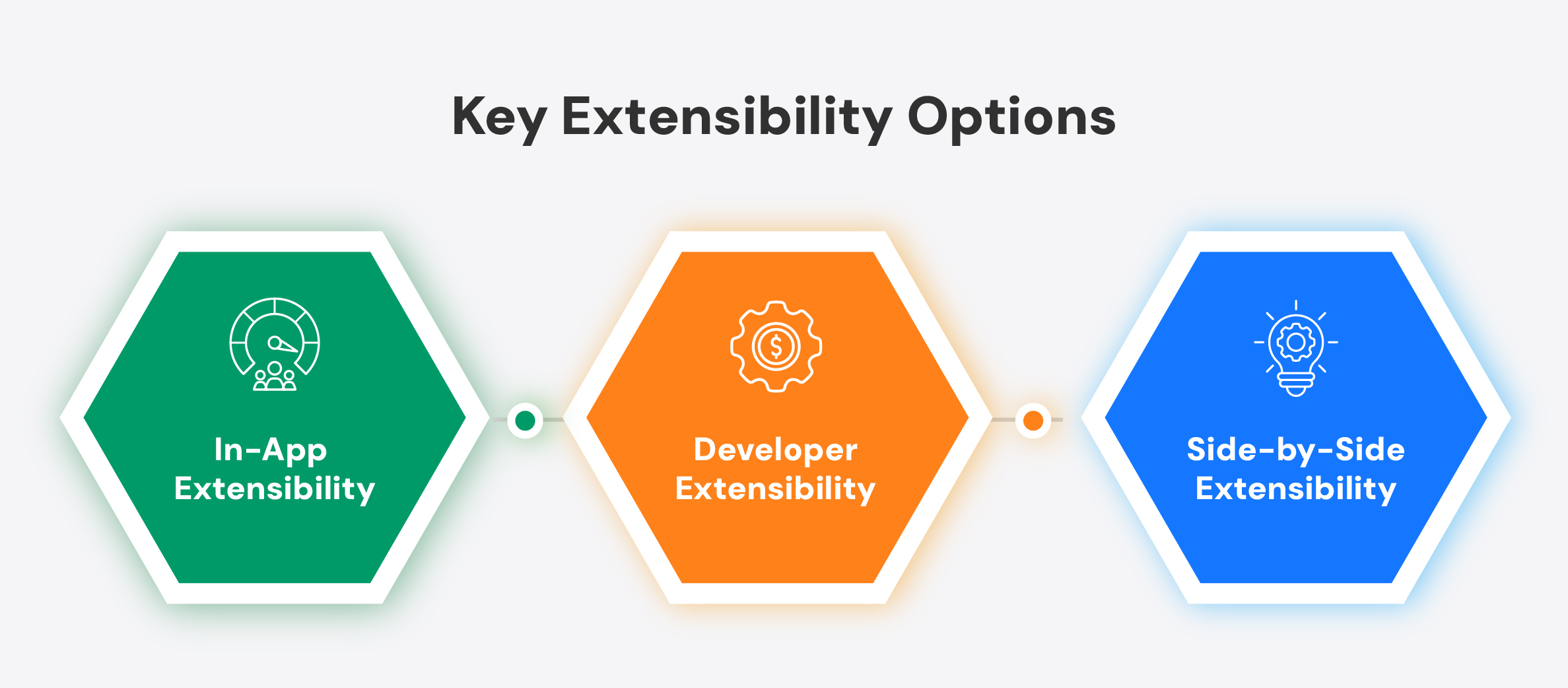One of SAP ECC and SAP S/4HANA’s primary features is extensibility. Customers can use it to personalize their corporate procedures, and partners can enhance ERP with unique solutions. Choosing the right SAP partner is essential for a successful implementation and avoiding challenges. This document gives project managers, key users, and ABAP developers an overview of the extensibility choices and recommendations for ABAP-based extensions on SAP S/4HANA in the cloud and on-premise.
This is causing difficulties for upgrading and making the process take a very long time. For instance, if we utilize a SAP item that SAP has not whitelisted, it may be modified or removed following an upgrade. The upgrade is now on hold as we will have to change the extension.
What is SAP S/4HANA Cloud Extensibility
Companies have the opportunity to utilize SAP S/4HANA Cloud Extensibility, which is a collection of capabilities and resources, to modify, upgrade, and expand the basic SAP S/4HANA Cloud system in accordance with their individual business needs, all while maintaining system integrity and compatibility with future updates.
Extensibility in a cloud ERP context ensures that the codebase of the core system will remain untouched and this opens the way for customization and development of new functionalities by companies. This is a core aspect since SAP S/4HANA Cloud follows the “clean core” principle that is designed to keep the key SAP functionality while promoting system integrity, security, and ease of upgrades.
How to Use SAP S/4HANA Cloud Extensibility
A platform that sustains business processes through extensibility needs to be embedded in a modular SAP application (like SAP Concur, SAP Ariba, or SAP App Center) although it is totally within the clients’ power to create their own application through SAP extensibility.
The capacity to detach is extensibility’s principal benefit. Without compromising the upgrades, this feature permits extensions in the SAP S/4HANA core. The main benefit of the SAP S/4HANA Cloud’s in-app and side-by-side extensibility principles is this decoupling, since reliable APIs interact across many system layers.
In addition to decoupling, SAP Extensibility offers the following advantages:
- Stands out from the usual herd.
- Provides a competitive edge that is very hard to beat
- Minimizes the demand for human work and helps in process simplification.
Explore how extensibility can drive innovation and adaptability in your business with our comprehensive SAP S/4HANA Cloud ERP Services.
How to Use In-App Extensibility Without Any Problems?
Customers can create their own extensions on SAP Cloud Platform using the provided APIs, thanks to the SAP S/4HANA in-app extensibility. However, because software is regularly patched and updated on a set timetable and innovations are always being added, such system integrations are prone to issues.
By guaranteeing decoupling and lifespan stability, this can be resolved. This is because these extensibilities are acceptable and do not impede the ability to update SAP software without the need for manual procedures. Additionally, custom extensions are weakly connected, allowing them to be detached without causing damage when updates are needed.
Key Extensibility Options
A foundation for extension that is adaptable to various business and technological requirements is offered by SAP S/4HANA Cloud. With the help of these extensibility options, businesses can improve and modify their ERP systems without compromising the SAP standard core’s stability or upgradeability. The major types of extensibility are In-App, Developer, and Side-by-Side. Each has its own purpose, the featured user, and the level of technical difficulty.
In-App Extensibility
Without developing custom code, business users and functional consultants can make changes immediately within the SAP S/4HANA Cloud system thanks to in-app extensibility, also referred to as key user extensibility. Its user-friendly and intuitive design enables businesses to respond swiftly to changes in the business environment.
Real-time application customization is possible through the SAP Fiori user interface’s Extensibility Cockpit and associated tools. Usually, in-app add-ons that are typically used are:
- Custom Fields and Logic: Users enable to use their custom logic made with Business Add-Ins (BAdIs) and to add fields to standard objects (like customers, products, or purchase orders) with the help of the Custom Fields and Logic app.
- UI Adaptations: Users can rename, conceal, and rearrange fields on SAP Fiori panels in order to meet workflow requirements or business terminology.
- Form and Report Modifications: Organization-specific information can be incorporated into standard print forms and analytical reports.
- Custom Business Objects: The most experienced users can not only design new business objects but also set their data models, deploy them in the workflows and analytics, and so on.
- Business Rules and Workflows: Customized processes excluding depreciation and penalties can be done with the help of the in-app tools like the Flexible Workflow and Business Rules Framework.
Developer Extensibility
Developer Extensibility (also known as Embedded Steampunk) links the cutting-edge cloud extensibility with the traditional ABAP programming. With ABAP Cloud, which is a limited and cloud-ready version of the ABAP language, developers can build complex extensions right inside the same SAP S/4HANA Cloud setting.
Deeper technical adaptations are possible with this expansion option while maintaining SAP’s clean core approach. Developers are able to: Construct unique business objects, services, and APIs that communicate with SAP standard objects.
- Put in place bespoke logic that safely and controlledly expands on standard processes.
- To guarantee compatibility in the future, use CDS views and disclosed APIs.
- The eclipse’s ABAP Development Tools provided the traditional ABAP developers with work and code editing done through a familiar and modern platform.
Side-by-Side Extensibility
Side-by-Side Extensibility allows businesses to use the SAP Business Technology Platform (SAP BTP) to externally extend SAP S/4HANA Cloud. Extensions are created as stand-alone apps that smoothly interface with the ERP system via APIs, events, and services rather than altering it directly.
With this strategy, businesses can innovate without restriction while keeping their core system robust and clean. Common use cases include creating mobile apps, integration flows, new user interfaces, and sophisticated analytics programs that use SAP S/4HANA Cloud data. The main functionalities of side-by-side extensibility are:
- Using SAP BTP Services: Developers can access services such as SAP Integration Suite, SAP Extension Suite, or SAP Build to build, integrate, and deploy custom applications.
- The developer’s choice of S/4HANA Cloud events is facilitated by the event-driven nature of SAP Event Mesh. They can do so two ways: being subscribers, and triggering external workflows or automations almost without any delay.
- Open APIs and CDS Views: When it comes to secure data communication, SAP S/4HANA Cloud has an extensive library of OData and REST APIs available.
- Development of Multi-Technology: Applications can be built in multiple languages namely, Python, Node.js, and Java, providing agility and quicker innovation cycles.
- Scalability and Lifecycle Management: The application level, where the extensions are located, can be updated, scaled, and managed totally independently of the ERP core on SAP BTP.
Benefits of SAP S/4HANA cloud Extensibility
Besides the bare surface, the extensibility of SAP S/4HANA Cloud is a powerful tool for businesses in a way that allows them to be adaptable in the market, innovate consistently, and keep a sound and neat digital core. By using SAP’s extensibility architecture, companies can make themselves conforming to the market and the technological shift that is happening.
Agility and Flexibility
One of SAP S/4HANA Cloud extensibility’s most significant attractions is business agility. Organizations operating in rapidly changing environments must readily mold functions, data structures, and user interfaces to meet the ever-changing demands.
The use of in-app and developer extensibility tools allows the companies to make the changes in their ERP systems as per the new conditions without affecting the main system. Extensibility opens up ways for the enterprises to make such changes promptly, safely and independently from SAP release cycles, whether the companies are developing a custom application on SAP BTP, adding a new field to collect business-specific data, or changing a process.
Such flexibility presents businesses with the opportunity to maintain innovations as well as improvements in the process by not only smoothly operationalizing but also continuously cooperating with the changes in the industry, customer needs, and regulation.
Reduced Total Cost of Ownership (TCO)
One of the main benefits of SAP S/4HANA Cloud extensibility is that it drastically reduces the total cost of ownership (TCO) by eliminating significant system modifications, which are time-consuming and costly, long development cycles, and manual upgrades.
The “keep the core clean” philosophy is supported by the extensibility framework, which makes sure that any modifications are controlled by secure and upgrade-friendly systems. This implies that companies can implement SAP’s quarterly upgrades and additions without having to undergo a lot of testing or rework due to core changes.
In addition, the business users will be able to take care of minor expansion without large IT involvement because of the availability of low-code and no-code solutions which decreases the need for professional development personnel, and this eventually leads to a drop in maintenance costs, faster deployments, and a more stable IT budget.
Faster Innovation
Speed of Innovation is a very decisive factor in the digital age. It is by nature SAP S/4HANA Cloud extensibility that it offers an open, modular architecture that supports both in-app and side-by-side development, that companies get to the new products quicker.
Businesses can use the new technologies like AI, ML, and advanced analytics by VMware without impacting the stability of their ERP due to SAP’s Business Technology Platform (BTP) integrations. Event-driven architectures, reusable services, and pre-built APIs are among the tools that help developers quickly create, test, and deploy new features.
The strategy results in a shorter time for the product to be launched in the market, quicker delivery of new business functionalities, and enables companies to gradually move towards the adoption of digital products or new business models. To summarize, giving room for changes makes SAP S/4HANA Cloud a rock-solid ERP system but a platform for continuous innovation instead.
Competitive Advantage
Every business stands out in the marketplace because of its own distinct procedures and differentiators. SAP S/4HANA Cloud extensibility allows companies to keep their skills and do-ups while taking the advantage of SAP’s defined best practices at the same time. Through the development of custom extensions, such as role-based dashboards, custom workflows, or advanced applications developed on SAP BTP, the companies can create unique user experiences and process flows that are perfectly aligned with their strategic goals. Along with that, if companies can easily communicate with partners, outside systems, and emerging technology, they can remain flexible and connected across the whole ecosystem. This flexibility is not only contributing to operational efficiency but also strengthening the competitive position by faster decision-making, better customer engagement, and more room for innovation.
Features of In-App Extensibility tools
One of SAP S/4HANA Cloud’s most potent capabilities is In-App Extensibility, which enables consultants, business users, and key users to directly customize the system without the need for traditional coding or in-depth technical knowledge. The clean core approach is supported by these tools, which are fully integrated into the SAP Fiori interface and guarantee that all modifications are compliant with SAP standards and upgrade-safe.
The primary features and features that constitute In-App Extensibility, a fundamental component of SAP S/4HANA Cloud adaptability, are listed below.
UI Adaptations
Through the use of UI Adaptations, the users can change and personalize the appearance of SAP Fiori applications from the user interface itself. The guided “Adapt UI” mode allows the users to make changes to views without needing to understand any programming.
- Adding or deleting fields from displays are examples of common UI adaption features.
- label renaming or field position rearrangement.
- Sections can be hidden or shown according to user roles or business requirements.
- making screen variations for particular user groups or workflows.
These visual changes preserve SAP’s design consistency while enhancing usability, improving user experience, and guaranteeing that each position has a screen layout that best suits its workflow.
Custom Fields
The Custom Fields and Logic app allows users to add new data fields for standard business objects such as customers, products, purchase orders, and sales orders. These fields can be utilized in multiple application layers, such as user interfaces, reports, forms, and APIs.
Key capabilities include:
- Defining field names, data types, and labels using a straightforward user interface
- Enabling the use of custom fields for certain services, analytical reports, or apps.
- incorporating custom fields automatically into OData services, CDS views, and UI elements.
Organizations can use this functionality to add organization-specific data to conventional business processes, improving alignment with specific operational requirements, all without changing the underlying core tables.
Custom Logic
With Custom Logic, you can use predefined Business Add-Ins (BAdIs) to include custom business rules or decision logic into regular SAP procedures. Custom code snippets can be implemented directly through the Custom Fields and Logic app at these secure, regulated improvement points.
Examples include:
- Adding validation criteria for particular business conditions.
- Modifying the calculating logic or pricing.
- Establishing unique default values for documents or fields.
SAP’s lifecycle management tools are used to manage all implemented logic, guaranteeing compatibility with upgrades. Without affecting the core SAP code, this functionality enables developers and key users to implement focused, business-specific behavior.
Custom Business Objects
In addition to normal SAP objects, users can construct completely new data entities and business logic models with Custom Business Objects (CBOs). Without the use of conventional development tools, these objects can be created, enabled, and maintained using a guided configuration interface.
Features include:
- Ability to define unique tables and data structures.
- establishing connections between standard and custom objects.
- automatically creating matching Fiori user interfaces and APIs.
- supporting CRUD (create, read, update, and delete) and other typical lifecycle actions.
CBOs offer businesses the ability to gather and manage data that doesn’t fit into typical SAP models, including internal project tracking or compliance data relevant to a given location.
Custom Analytics
Users can create their own analytical data models and reports with the help of the Custom Analytical Queries and Custom CDS Views tools. Users can generate valuable insights suited to their own KPIs or reporting needs by fusing conventional and custom data sources.
Important features include of:
- constructing unique CDS views without knowing any code.
- integrating several data sources into a single model for analysis.
- constructing dashboards and reports with an interactive Fiori foundation.
- granting corporate users the ability to drill down and filter.
By empowering people to create their own data views and reports, these solutions democratize analytics by decreasing dependency on developers or IT and speeding up decision-making.
Decoupling and Upgrade Safety
In-App Extensibility’s upgrade-safe design is one of its main advantages. SAP’s extension system ensures that any customizations are implemented independently of the core software. Organizations planning a migration can reduce risks and align extensions with best practices by using a SAP ECC to S/4HANA conversion guide.
These extensions are not affected by SAP’s quarterly upgrades, thus there is no need for reimplementation or intensive regression testing. Organizations can develop continuously while preserving operational stability and guaranteeing adherence to SAP’s clean core philosophy thanks to this decoupling methodology.
Low-Code/No-Code Approach
In-App Extensibility is a perfect example of the low-code/no-code philosophy, as it allows critical users and business experts to do customizations without developer participation which was the case before.
Using user-friendly Fiori applications, users can:
- Make extensions using straightforward form-based user interfaces.
- Use configuration, not code, to automate logic.
- Immediately implement changes without requiring drawn-out development periods.
This empowerment promotes better communication between technical and business teams, speeds up deployment schedules, and lessens IT bottlenecks.
Integration and Management
A comprehensive architecture for controlling and integrating in-app extensions throughout the system landscape is offered by SAP. To maintain control and transparency, the Extensibility Cockpit is used to deploy and oversee any extensions.
Key capabilities include:
- Centralized lifecycle management and monitoring of all in-app extensions.
- Custom fields and objects can be integrated with SAP BTP side-by-side apps and external APIs.
- same deployment procedures in production, test, and development environments.
This centralized governance by ensuring that extensions are compliant, maintainable, and in line with the enterprise architecture guidelines promotes the long-term, sustainable growth of the system.
Side by Side Extensibility of SAP S/4HANA Cloud
Side-by-Side Extensibility is a key pillar of the SAP S/4HANA Cloud extensibility strategy. It allows businesses to use the SAP Business Technology Platform (SAP BTP) to externally extend their ERP system without changing the core system. This methodology provides freedom to develop innovative, scalable, and upgrade-safe apps that integrate smoothly with S/4HANA Cloud, all while supporting SAP’s clean core philosophy.
Shifting the extensions from the core ERP allows the organizations to reap the benefits of the latest technologies such as AI, machine learning, IoT, and analytics, as well as to integrate with external platforms, and to use modern development frameworks. All of this comes at the price of system stability and continuous upgradeability.
Different Integration Patterns for Side-by-Side Extensibility
A variety of integration patterns, each intended to meet distinct technical and commercial requirements, are supported via side-by-side extensibility. These patterns specify how services and apps created on SAP BTP or other platforms communicate with SAP S/4HANA Cloud.
- Integration Using APIs
A wide range of OData and REST APIs are exposed by SAP S/4HANA Cloud, enabling real-time, two-way communication between the ERP system and external apps. This facilitates process extensions across platforms and permits the safe exchange of corporate data.
- Event-Driven Integration
Via SAP Event Mesh, events produced in S/4HANA Cloud can be shared and received by outside systems. This ensures that the extensions are able to scale and respond promptly due to the real-time connection with business events. - Data Replication and Virtual Access
Data from SAP S/4HANA Cloud can be virtually accessed or duplicated into platforms like SAP Datasphere or SAP HANA Cloud for analytical or data-intensive use cases. This allows for thorough analytics and insights without affecting the functionality of ERP. - Extension Applications on SAP BTP
SAP Cloud Application Programming Model (CAP) and SAP Build are the two modern frameworks that developers can rely on to produce and deploy apps on SAP BTP. These applications are not included in the core but rather through APIs that interact with SAP S/4HANA Cloud to offer additional functionalities and user interfaces. - Integration through SAP Integration Suite
SAP Integration Suite provides a centralized middleware layer for the seamless coordination of integrations among SAP BTP, SAP S/4HANA Cloud, and outside systems. It has preloaded material for common integration scenarios and supports a number of connection protocols.
This means that when adopting these patterns, companies can set up a flexible and manageable architecture that brings the benefits of SAP S/4HANA Cloud while they can still receive regular upgrades and retain their system stability.
Use Cases for Side-by-Side Extensibility
The side-by-side extension is the answer for the situations where there is a need for creativity, integration, or capabilities which are more than involved in the regular S/4HANA Cloud system. This way, companies can strengthen their skills at the same time as the ERP core remains intact.
The main use cases are as follows:
- The major use cases are listed below:
- Custom Applications and User Interfaces: To build new user interfaces and applications for improving standard SAP Fiori apps and for accommodating specific business processes or local requirements.
- Advanced Analytics and AI Integration: Using SAP BTP services for getting predictive insights, analytics, and machine learning that are all in harmony with the main business data.
- Workflow Extensions and Process Automation: With SAP Build Process Automation or Workflow Management, one can introduce personalized automation, approvals, or orchestration into core business workflows.
- Third-Party System Integration: It is the process of setting up seamless connections between the outside ecosystems and SAP S/4HANA Cloud for the purpose of facilitating data interchange and real-time collaboration.
- Industry-Specific Solutions: It is the adding of distinctive features that are specifically meant for certain business models or sectors to the SAP’s core capability.
- Innovation and Experimentation: Piloting and rolling out new digital innovations or technologies without the risk of negatively affecting the stability or performance of the core ERP system.
Unlock Innovation with SAP BTP
Boost innovation and flexibility in SAP S/4HANA Cloud using SAP Business Technology Platform for seamless extensions and integrations.
How Do the On-premise and the Cloud Services Vary in Terms of Available Extensibility?
SAP S/4HANA is presented in a manner of both on-premise and cloud deployment. The functional core of the two systems is practically the same; however, the options for expansion vary enormously. The dissimilarities are mainly linked to the operational duties and design philosophies of both the models in particular with respect to system control, upgrade frequency, and customization allowed.
When the goal is to the future-proofed sustainable, compliant extensions then, the understanding of the distinction in extensibility between on-premise and cloud versions becomes very important.
Extensibility in SAP S/4HANA On-Premise
In on-premise models, the ABAP stack, database, and application server are the complete responsibility of the organization. A wide variety of expansion choices are made possible by this autonomy, ranging from settings and custom code to changes to SAP’s standard objects.
Key characteristics of on-premise extensibility include:
- Complete Technical Flexibility:
Customers have direct access to the entire suite of SAP tables, programs, and improvements, as well as the ability to alter standard SAP objects and deploy bespoke ABAP code. - Classic (In-Stack) Extensions:
Classic (In-Stack) Extensions: All of the conventional modification methods are supported, including enhancements, user exits, and implicit or explicit changes. Deep, process-level customizations are possible as a result, however, there may be upgrade difficulties. - Full Development Environment:
Using the standard ABAP Workbench, developers can design bespoke programs, function modules, transactions, and data models. Middleware or specially designed interfaces can also be used to integrate with non-SAP systems. - Upgrade Dependency:
Every system upgrade or support package may need to have its custom code modified or revalidated since changes impact the core system. Such a scenario usually leads to longer upgrade cycles as well as higher maintenance costs.
In fact, the on-premise structure provides the most flexibility and control, but at the same time, it requires very strict management and permanent maintenance to manage code conflicts, keep compliance, and maintain system stability through the years.
Extensibility in SAP S/4HANA Cloud
SAP S/4HANA Cloud is all about scaling, standardization, and constant innovation. The cloud concept is based on SAP’s “clean core” philosophy, which encourages upgrade-safe, decoupled expansion techniques while limiting direct changes to the fundamental system.
Key characteristics of cloud extensibility include:
- No Core Modifications:
Direct modifications to ABAP code or SAP standard objects are prohibited. This guarantees the seamless and automatic implementation of quarterly upgrades. - In-App Extensibility:
UI Adaptation applications, Custom Fields and Logic, and Custom Business Objects are examples of no-code technologies that allow business and key users to modify the system. Since these extensions are built into the system, they are safe for upgrades. - Developer Extensibility (Embedded Steampunk):
ABAP Cloud can be used by developers in the same S/4HANA Cloud environment for more intricate enhancements. This ensures compatibility in the future by enabling regulated ABAP development based on whitelisted APIs and CDS views. - Side-by-Side Extensibility:
The SAP Business Technology Platform (BTP) is the basis for larger or more independent extensions. These applications interact with S/4HANA Cloud using events and APIs, thus allowing the ERP core to be protected while still being flexible and creative. - Automatic Lifecycle Management:
Since SAP oversees security updates, patches, and system upgrades, all extensions must abide by SAP’s upgrade-safe and governance policies.
All things considered, SAP S/4HANA Cloud places more emphasis on agility, stability, and compliance than on unfettered customization. Faster innovation cycles, reduced total cost of ownership, and predictable system behavior are made possible by this strategy.
Conclusion
The key to SAP S/4HANA Cloud’s capacity to provide both standardization and flexibility in a business environment that is changing quickly is extensibility. By embracing a clean core philosophy, SAP gives businesses the confidence to innovate and expand their ERP capabilities without sacrificing performance, stability, or upgrade readiness. The successful implementation of these extensibility options and their alignment with industry best practices can be further ensured by collaborating with a SAP Gold Partner company.
Regardless of whether it is via Side-by-Side Extensibility for the development of cloud-native applications on SAP Business Technology Platform (BTP), Developer Extensibility for controlled ABAP development, or In-App Extensibility for basic adaptations, businesses have a wide range of options to tailor their ERP environment to their specific needs.
Ultimately, the Extensibility of SAP S/4HANA Cloud empowers companies to build a strong, future-proof digital foundation that fosters uninterrupted innovation, remains agile in aligning with business strategy, and helps them stay ahead of the competition in the digital marketplace.
SAP Solution Architect with 23+ years in logistics and SCM. Expert in SAP S/4HANA with hands-on experience in global rollouts, upgrades, and enterprise solution delivery.







